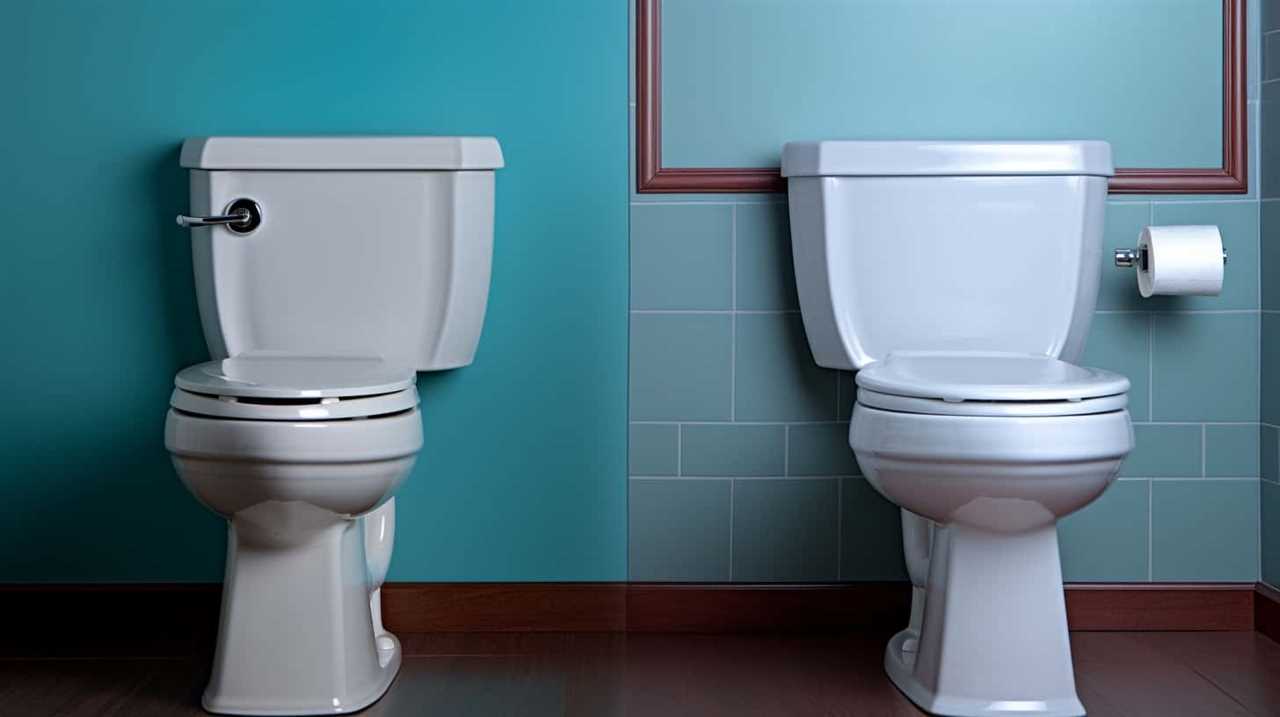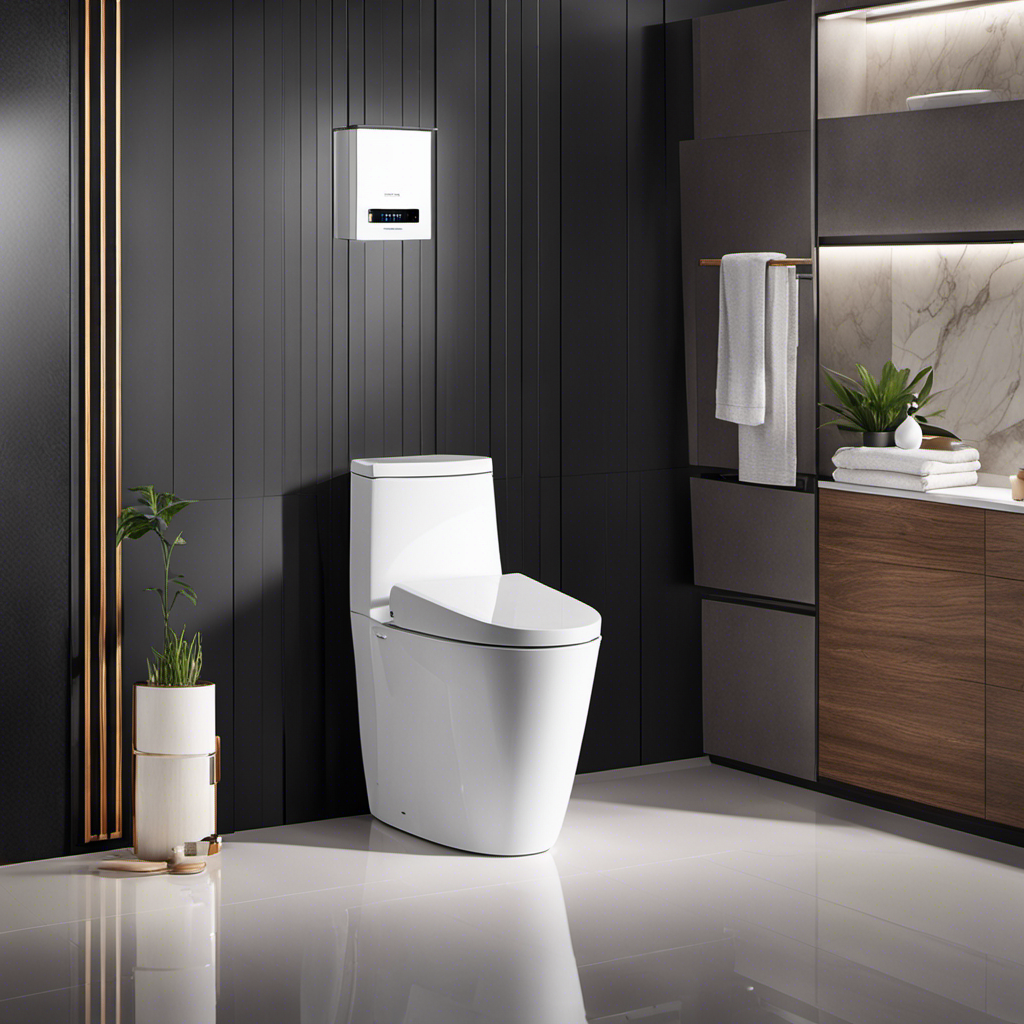I know what you’re thinking – turning off a toilet? Why would anyone need to do that?
Well, let me tell you, there are situations where knowing how to turn off a toilet can be a real lifesaver. Whether you’re dealing with a stubborn clog, a leak, or simply need to perform some maintenance, being able to shut off the water supply is a valuable skill.
In this article, I’ll walk you through the step-by-step process of safely and effectively turning off a toilet. So, let’s get started!
Key Takeaways
- Knowing how to turn off a toilet is important for dealing with stubborn clogs, leaks, or performing maintenance.
- Regular shut-off valve maintenance is essential to prevent issues and ensure proper functioning.
- The shut-off valve is usually located near the floor or wall behind the toilet.
- Turning off the water supply by shutting off the valve stops the water flow and allows for draining the tank.
Locating the Shut-off Valve
First, you’ll want to find the shut-off valve for the toilet. The shut-off valve is a crucial component of your toilet’s plumbing system. It controls the flow of water to and from the toilet, allowing you to turn off the water supply in case of emergencies or maintenance needs.
Common shut-off valve problems include leaks, worn-out seals, and corrosion. Regular shut-off valve maintenance is essential to prevent these issues and ensure its proper functioning. It is recommended to inspect the shut-off valve periodically for any signs of damage or leaks. Additionally, turning the valve on and off a few times every few months can help prevent it from seizing up.
Turning the Water Supply off
To stop the water flow, you can simply shut the valve on the water supply line. This valve is usually located near the floor or wall behind the toilet. It’s important to familiarize yourself with this valve in case of common toilet problems, such as leaks.
Troubleshooting toilet leaks can be a messy and inconvenient task, but by following these steps, you can quickly and effectively stop the water flow:
- Turn off the water supply valve by turning it clockwise.
- Flush the toilet to drain any remaining water in the tank.
- Use a towel or sponge to soak up any water that may have leaked onto the floor.
Shutting off the Flush Valve
The valve behind the toilet can easily be shut to stop the flow of water. To shut off the flush valve, locate the water supply valve, usually located behind the toilet near the floor. Turn the valve clockwise to shut off the water supply. This will stop the flow of water into the toilet tank, preventing any potential leaks or water damage.
If you are replacing the flush handle or adjusting the water level in the toilet tank, it is essential to shut off the flush valve first. This will prevent any accidental flushing or overflow while you work on the toilet.
Here is a table showcasing the steps to shut off the flush valve:
| Steps | Description |
|---|---|
| Step 1 | Locate the water supply valve behind the toilet. |
| Step 2 | Turn the valve clockwise to shut off the water supply. |
| Step 3 | Verify that the water flow has stopped by flushing the toilet. |
Disabling the Fill Valve
Once the water supply is shut off, you can disable the fill valve for further maintenance. To disable the fill valve, follow these steps:
- Locate the fill valve, which is usually located on the left side of the toilet tank.
- Turn the fill valve clockwise to loosen it from the tank.
- Gently lift the fill valve out of the tank, being careful not to damage any surrounding parts.
Disabling the fill valve is an important step in replacing the toilet or performing flush valve maintenance. By following these steps, you can ensure that the fill valve is properly disconnected from the water supply and ready for further repairs or replacement.
Remember to always exercise caution when working with plumbing fixtures to prevent any damage or accidents.
Ensuring the Toilet Is Completely Turned off
Make sure you’ve completely shut down the water supply to guarantee that the toilet is properly disabled. Once you’ve turned off the water, it’s important to ensure that there are no leaks or residual water in the toilet tank or bowl.
Start by checking the water supply line and connections for any signs of leakage. If you notice any, tighten the connections or replace the faulty parts.
Next, inspect the fill valve and flush valve for any leaks or drips. These are common areas for water to escape and can cause ongoing issues if not addressed.
Additionally, it’s crucial to practice proper maintenance techniques, such as regularly cleaning the toilet and checking for any worn-out parts that may need replacement.
Frequently Asked Questions
Can I Turn off the Toilet Without Locating the Shut-Off Valve?
I can stop the toilet water flow without finding the shut-off valve. There are alternative ways, like lifting the float or shutting off the main water supply to the entire house.
How Do I Know if I Have Successfully Turned off the Water Supply?
To check if the water supply is off, I look for signs like no water running in the toilet tank or no flushing. If there are still issues, I troubleshoot common problems like a faulty shut-off valve or leaks.
What Happens if I Accidentally Shut off the Flush Valve Instead of the Water Supply?
If the flush valve is accidentally shut off instead of the water supply, the toilet will not be able to flush properly. The flush valve controls the flow of water into the toilet bowl.
Is It Necessary to Disable the Fill Valve When Turning off a Toilet?
It is not necessary to disable the fill valve when turning off a toilet. However, it is crucial to properly shut off the water supply to prevent any potential leaks or damage.
Are There Any Additional Steps I Need to Take to Ensure the Toilet Is Completely Turned Off?
To ensure the toilet is completely turned off, I need to take a few additional steps. First, I’ll check for leaks by inspecting the water supply line. Then, I’ll drain the toilet by shutting off the water valve and flushing it.
Conclusion
So there you have it, folks, a step-by-step guide on how to turn off a toilet. By following these instructions, you can easily locate and shut off the necessary valves to prevent any water flow.
Remember, when dealing with plumbing, it’s always better to be safe than sorry. If you find yourself in a sticky situation, don’t hesitate to call a professional plumber.
After all, it’s better to leave no stone unturned and ensure the toilet is completely turned off. And as the saying goes, ‘Better safe than sorry!’










